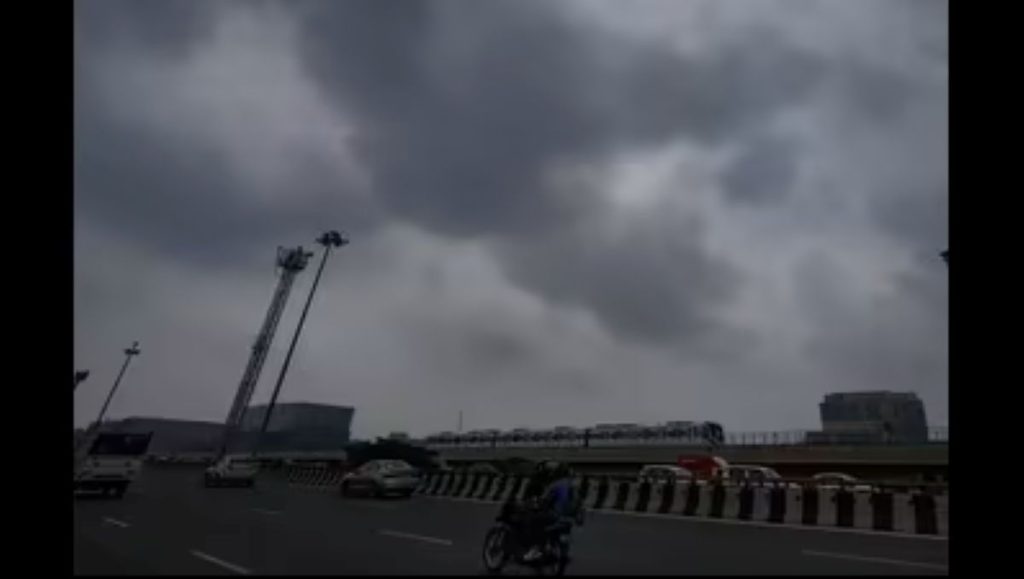New Delhi, June 23, 2025 — The India Meteorological Department (IMD) has issued a yellow alert for Delhi, Gurgaon, and Faridabad today, forecasting heavy rainfall, thunderstorms, lightning, and gusty winds. These weather patterns are signs of the incoming Southwest Monsoon, which is now expected to make an early onset in Delhi-NCR by June 24, possibly making it one of the earliest arrivals in over a decade.
The alert comes amid a series of pre-monsoon showers that have already begun affecting parts of northern and central India. As Delhiites brace for potential waterlogging and traffic disruptions, experts have weighed in on what this means for the region’s climate stability, urban infrastructure, and agriculture.
Yellow Alert Issued for Delhi, Gurgaon, Faridabad
According to the IMD, Delhi and its satellite cities — Gurgaon and Faridabad — are under a yellow category warning for Monday and Tuesday. The warning advises residents to stay indoors during thunderstorms and to avoid open areas where lightning strikes may pose serious threats.
Key IMD forecasts:
- Winds: 30–40 km/h, with gusts possibly reaching 50 km/h
- Lightning: High frequency over urban and semi-urban belts
- Rainfall: Light to moderate showers, with isolated heavy downpours
- Temperature Dip: Maximum temperatures may fall by 4–5°C over the next 24 hours
Monsoon 2025: Early Arrival in North India
As per the latest monsoon progress chart by the IMD, the southwest monsoon has already advanced into:
- Entire Ladakh, Jammu & Kashmir, Himachal Pradesh
- Parts of Punjab, Uttarakhand, and northwest Uttar Pradesh
- The IMD expects monsoon winds to sweep into Delhi-NCR, Haryana, Chandigarh, and parts of Rajasthan by June 24, which, if confirmed,
- would mark the earliest monsoon onset in Delhi since 2013. That year, the rains arrived on June 16, well ahead of the usual June 27–29 average.
Read about Delhi’s monsoon trends over the years.
Weather Systems Behind the Change
Several atmospheric factors are accelerating the arrival of the monsoon into northern India:
- Low-Pressure Area: Located over southeast Uttar Pradesh, intensifying moisture inflow
- Trough Line: Extended from northwest Rajasthan to Bihar, promoting uplift and raincloud formation
- Cyclonic Circulation: Around south UP and north MP, fueling instability
These combined systems are expected to trigger consistent rainfall over the next 48–72 hours, making conditions favorable for the onset of the monsoon in Delhi-NCR.
What Citizens Should Know
With frequent lightning, thunder, and localized flooding, residents are advised to:
- Avoid unnecessary travel, especially during peak rain hours
- Secure loose objects on terraces or balconies
- Stay away from waterlogged streets and underpasses
- Use public transit cautiously, and expect delays due to traffic congestion
Public safety officials have alerted local municipalities in Gurgaon, Faridabad, and Delhi to prepare for potential waterlogging, particularly in low-lying areas like Okhla, Karol Bagh, Badarpur, and DLF Phase III.
Temperature Outlook & Air Quality
The arrival of monsoon winds is also expected to bring relief from the prevailing heatwave conditions. Delhi’s maximum temperature may drop to around 32°C, a significant dip from the 40+ highs recorded earlier in June.
In addition, the increased humidity and rains will temporarily improve air quality, pushing PM2.5 and PM10 levels into the moderate category for a few days. However, experts caution that this relief is short-lived unless followed by structural changes in emissions and waste management.
Impact Across North India
It’s not just Delhi-NCR witnessing a shift. Rainfall has been reported in:
- Punjab: Amritsar, Ludhiana
- Himachal Pradesh: Shimla, Solan
- Uttarakhand: Dehradun, Nainital
- Rajasthan: Jaipur, Bharatpur
Cities like Lucknow and Kanpur also reported intermittent showers, reducing power demand and improving water table recharge across some zones.
When the Rain Comes Early: Pros & Concerns
While the early arrival of the monsoon brings joy for many, meteorologists and planners urge caution:
Advantages
- Boosts sowing of kharif crops like paddy, maize, and cotton
- Reduces urban electricity consumption due to lower A/C demand
- Improves water reservoir levels after a dry May
Challenges
- Sudden intense rain can lead to urban flooding
- Excess moisture may lead to crop fungal diseases if not managed
- False start: If the rain is not sustained, it could disrupt farming schedules
How to Track the Monsoon
Stay updated via:
Stay Updated: Delhi-NCR on Yellow Alert as Monsoon Hits Early On Prime Feeds
